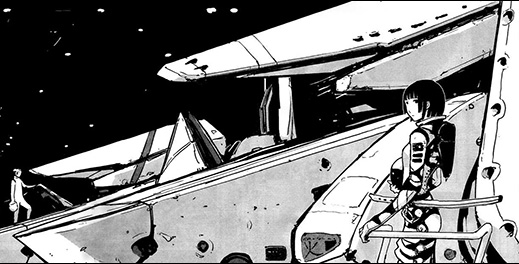Knights of Sidonia, vols 1 and 2
While I do occasionally dabble in the sci-fi genres, I tend to avoid anything involving mechas. Besides not being particularly interested in battle comics, I think oversaturation in my youth led to mecha-fatigue. Two series of Voltron and a religious devotion to all three Robotech seasons left me a bit spent. Throw in some Battletech gaming as well as all the giant-robot stuff that littered the culturescape of my youth (Transformers, Tranzor-Z, Johnny Sokko) and it might not be difficult to see why I might weary of the stuff. Around 2003, after about a ten-year abstinence, someone convinced me I should give Neon Genesis Evangelion a shot—that didn't go so well and I basically gave up on mechas for good.

Obviously, this was unfair and premature—like saying I don't like country music just because I haven't heard any country music I've ever appreciated.
It's easy to propose—on purely rational terms—that prejudices are always unfair. It makes sense. The argument is valid and cogent. Of course, that doesn't stop every last one of us from building lives on irrational presuppositions and convenient generalizations. I haven't questioned my belief that mecha stories are substandard fare because, well, primarily that would give me one more direction in which to apportion my already far-too-small disposable income. Also: though I read comics all the time and spend at least six hours per week writing about them, at least I don't read the ones with big robots on the covers because that's infantile.11I mean, not really, but that's the feeling I always had for mechas and giant robots, kind of a reverse nostalgia. So when I sat down and read Knights of Sidonia and had my worldview shattered? That was a feeling both delicious and terrifying. After all: I am now someone who reads and enjoys mecha manga.22Or at least one particular example of the genre.

For a reluctant reader such as myself,33Or even moreso, like my wife who is still less willing to pick up sci-fi than I am. I tricked her into reading Knights by saying how little I cared for the genre and then expressing how excited I was to read future volumes. I mean, I guess that's not so much a trick as it is just a flat statement of How Things Are. In any case, she reluctantly picked up the first volume and happily picked up the second. So there's that. Knights of Sidonia has a number of things working in its favour.
(It wasn't an instant sell. I hesitated to pick up the first volume. It wasn't my thing. I read the first chapter. And then the second. It had some intriguing sci-fi ideas,44...Interesting ideas that may very well be old hat for rigourous fans of the genres (those who may be well-accustomed to the common tropes), but at least for a reader who only occasionally encounters sci-fi, Knights of Sidonia had quite a few interesting future-concepts at play. but mere ideas aren't enough to buy my interest any more. So a few more chapters. This is kind of weird but kind of neat. And I like these characters. And some of the mystery of what's going on. So I pick up and read the second volume and Wow! Suddenly I'm sold on these characters and invested and Oh yes and Oh no and What Is Going to Happen Next WHERE IS VOLUME 3??)

To its credit, Knights of Sidonia is both conceptually smart and plenty imaginative. Series lead Tanikaze is one of the few humans onboard the Sidonia who cannot photosynthesize and requires regular meals of actual food. As would be scientifically likely, the fact that he has a diet at all means that he'd smell differently from other members of the ship's ecosystem. All over the ship are hand-holds and bars on which crew and residents can attach carabiners for when the ship turns and gravity changes. In the first chapter, we find that cloning is commonplace, and by the second we're introduced to Shinatose who's neither male nor female but can reproduce with either sex.55I haven't yet sussed out what pronoun they use to refer to Shinatose. Since she seems paired to Tanikaze as a possible romantic association, I imagine she'd take the female pronoun because he codes heterosexual and masculine.
The series as well features a kind of lo-fi elegance to its art. Illustrationwise, Nihei maintains good control of his visual space. While there is sometimes a lot of activity in panels (especially when in battle with the Gauna66So far, the alien Gauna are the series heavies—though I wouldn't be surprised for there to be some sort of reevaluation or reversal in later chapters.), it's generally not difficult to determine what is going on. (Though to be fair and honest, my critical sense tends to disengage during battles. I find myself rushing through to get back to the good stuff, the interpersonal junk.) At any rate, all remaining interpretive difficulties were smoothed away on a subsequent reading. And it says something worthwhile to note that there was a subsequent reading—and that there will likely be more to come as I return to re-acquaint myself with the story-so-far as future volumes are released.

Initially there was one thing that kept me at distance from the book. Nihei posits story moments in a kind of staccato kind of articulation. The cuts from one piece to the next are crisp and rely only on thematic shifts in the art (rather than employing narrative bubbles). The effect was a bit jarring on my first read and I felt that I was missing things. A second (and then third) reading proved that more likely I was reading carelessly—as I no longer felt that estrangement from the plot and had no such issue with the second volume. It may also be that I have grown accustomed to Nihei's style of visual storytelling.
If you're looking for some interesting sci-fi, it may be that you won't go wrong to check out this series. Remember that when I recommend this, I'm a reader who's just as invested in mechas as I am in bicycles or tricked-out lawnmowers or tandem strollers or any number of other things I don't care about at all. This is a mecha book that doesn't really feel like it's about mechas.77To be fair, I suppose it's possible that 98% of all mecha manga aren't really about their giant-robot-looking vehicles. That would be really kinda cool, I guess—though I'm not then sure what the point would be. Knights of Sidonia feels like a series of character studies in what would be a drastically different social environment from our own, only punctuated by colossal acts of violence. And so far, it's pretty keen. I'll grant that I'm only two volumes in and it's entirely possible that the book could go catastrophically wrong (like 90% of television series as the seasons wear on), but for now Knights of Sidonia excites me in a way that I hadn't expected. I want to know what happens to Tanikaze and Shinatose and Hoshijiro. And I'm especially interested to see which character gets the privilege of breaking Kunato's neck. That bastard.
Good Ok Bad features reviews of comics, graphic novels, manga, et cetera using a rare and auspicious three-star rating system. Point systems are notoriously fiddly, so here it's been pared down to three simple possibilities:
3 Stars = Good
2 Stars = Ok
1 Star = Bad
I am Seth T. Hahne and these are my reviews.
Browse Reviews By
Other Features
- Best Books of the Year:
- Top 50 of 2024
- Top 50 of 2023
- Top 100 of 2020-22
- Top 75 of 2019
- Top 50 of 2018
- Top 75 of 2017
- Top 75 of 2016
- Top 75 of 2015
- Top 75 of 2014
- Top 35 of 2013
- Top 25 of 2012
- Top 10 of 2011
- Popular Sections:
- All-Time Top 500
- All the Boardgames I've Played
- All the Anime Series I've Seen
- All the Animated Films I've Seen
- Top 75 by Female Creators
- Kids Recommendations
- What I Read: A Reading Log
- Other Features:
- Bookclub Study Guides










